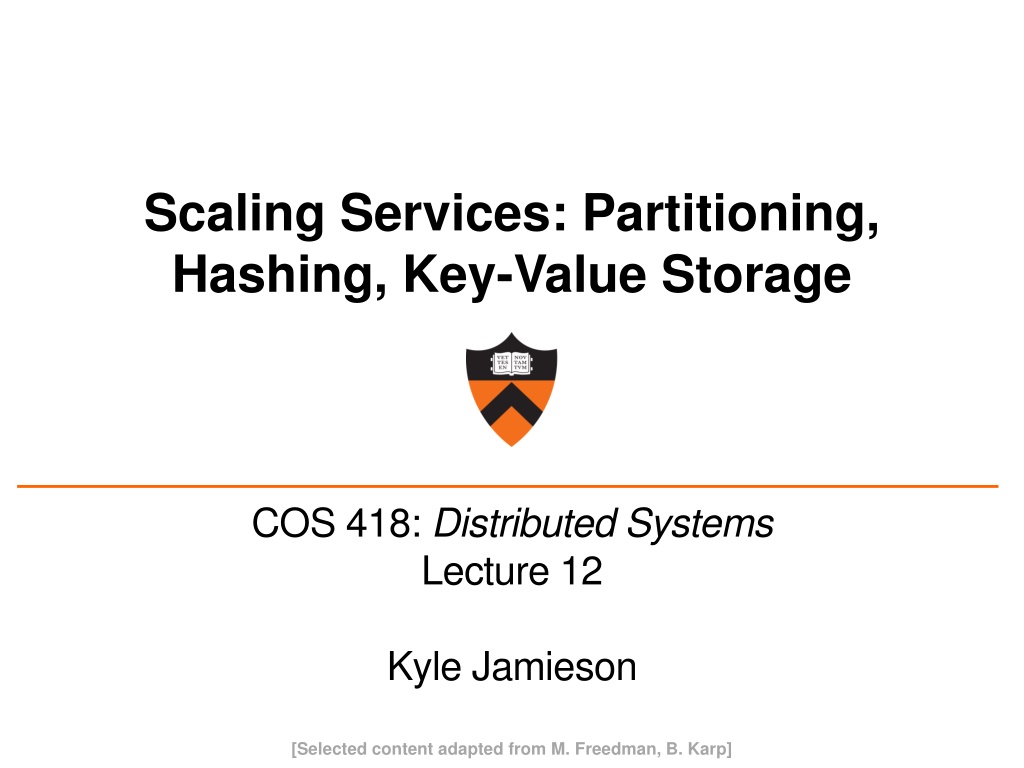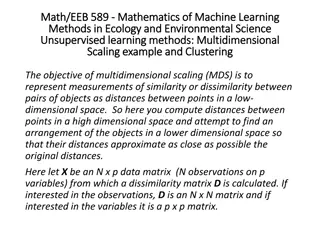Scaling Services and Key-Value Storage Techniques
This content delves into various aspects of scaling services, including partitioning, hashing, and key-value storage. It discusses vertical and horizontal scalability, the chaotic nature of horizontal scaling, techniques for partitioning data, and case studies like Amazon Dynamo. The importance of partitioning management, data placement, and modulo hashing are also explored, along with challenges and solutions regarding changing numbers of servers. Consistent hashing and its features are highlighted for optimal object distribution.
Download Presentation

Please find below an Image/Link to download the presentation.
The content on the website is provided AS IS for your information and personal use only. It may not be sold, licensed, or shared on other websites without obtaining consent from the author.If you encounter any issues during the download, it is possible that the publisher has removed the file from their server.
You are allowed to download the files provided on this website for personal or commercial use, subject to the condition that they are used lawfully. All files are the property of their respective owners.
The content on the website is provided AS IS for your information and personal use only. It may not be sold, licensed, or shared on other websites without obtaining consent from the author.
E N D
Presentation Transcript
Scaling Services: Partitioning, Hashing, Key-Value Storage COS 418: Distributed Systems Lecture 12 Kyle Jamieson [Selected content adapted from M. Freedman, B. Karp]
Horizontal or vertical scalability? Vertical Scaling Horizontal Scaling 2
Horizontal scaling is chaotic Probability of any failure in given period = 1 (1 p)n p = probability a machine fails in given period n = number of machines For 50Kmachines, each with 99.99966% available 16% of the time, data center experiences failures For 100K machines, failures 30% of the time! 3
Today 1. Techniques for partitioning data Metrics for success 2. Case study: Amazon Dynamo key-value store 4
Scaling out: Partition and place Partition management Including how to recover from node failure e.g., bringing another node into partition group Changes in system size, i.e.nodes joining/leaving Data placement On which node(s) to place a partition? Maintain mapping from data object to responsible node(s) Centralized: Cluster manager Decentralized: Deterministic hashing and algorithms 5
Modulo hashing Consider problem of data partition: Given object id X, choose one of k servers to use Suppose instead we use modulo hashing: Place X on server i = hash(X) mod k What happens if a server fails or joins (k k 1)? or different clients have different estimate of k? 6
Problem for modulo hashing: Changing number of servers h(x) = x + 1 (mod 4) Add one machine: h(x) = x + 1(mod 5) Server 4 3 All entries get remapped to new nodes! Need to move objects over the network 2 1 0 5 7 10 11 27 29 36 38 40 Object serial number 7
Consistent hashing Assign ntokens to random points on mod 2k circle; hash key size = k Hash object to random circle position Put object in closest clockwise bucket successor(key) bucket 0 14 Token 12 4 Bucket 8 Desired features Balance: No bucket has too many objects Smoothness: Addition/removal of token minimizes object movements for other buckets 8
Consistent hashings load balancing problem Each node owns 1/nth of the ID space in expectation Says nothing of request load per bucket If a node fails, its successor takes over bucket Smoothness goal : Only localized shift, not O(n) But now successor owns two buckets: 2/nth of key space The failure has upset the load balance 9
Virtual nodes Idea: Each physical node now maintains v > 1 tokens Each token corresponds to a virtual node Each virtual node owns an expected 1/(vn)thof ID space Upon a physical node s failure,v successors take over, each now stores (v+1)/v 1/nthof ID space Result: Better load balance with larger v 10
Today 1. Techniques for partitioning data 2. Case study: the Amazon Dynamo key- value store 11
Dynamo: The P2P context Chord and DHash intended for wide-area P2P systems Individual nodes at Internet s edge, file sharing Central challenges: low-latency key lookup with small forwarding state per node Techniques: Consistent hashing to map keys to nodes Replication at successors for availability under failure 12
Amazons workload (in 2007) Tens of thousands of servers in globally-distributed data centers Peak load: Tens of millions of customers Tiered service-oriented architecture Stateless web page rendering servers, atop Stateless aggregator servers, atop Stateful data stores (e.g.Dynamo) put( ), get( ): values usually less than 1 MB 13
How does Amazon use Dynamo? Shopping cart Session info Maybe recently visited products et c.? Product list Mostly read-only, replication for high read throughput 14
Dynamo requirements Highly available writes despite failures Despite disks failing, network routes flapping, data centers destroyed by tornadoes Always respond quickly, even during failures replication authorization (used in a non-hostile environment) Non-requirement: Security, viz. authentication, Low request-response latency: focus on 99.9% SLA Incrementally scalable as servers grow to workload Adding nodes should be seamless Comprehensible conflict resolution High availability in above sense implies conflicts 15
Design questions How is data placed and replicated? How are requests routed and handled in a replicated system? How to cope with temporary and permanent node failures? 16
Dynamos system interface Basic interface is a key-value store get(k) and put(k, v) Keys and values opaque to Dynamo get(key) value, context Returns one value or multiple conflicting values Context describes version(s) of value(s) put(key, context, value) OK Context indicates which versions this version supersedes or merges 17
Dynamos techniques Place replicated data on nodes with consistent hashing Maintain consistency of replicated data with vector clocks Eventual consistency for replicated data: prioritize success and low latency of writes over reads And availability over consistency (unlike DBs) Efficiently synchronizereplicas using Merkle trees Key trade-offs: Response time vs. consistency vs. durability 18
Data placement Key K put(K, ), get(K) requests go to me Table 1: Summary of techniques used in Dynamo and their advantages. Key K A Problem Technique Advantage G Coordinator node Partitioning Consistent Hashing Incremental Scalability B Nodes B, C and D store keys in range (A,B) including K. High Availability for writes Vector clocks with reconciliation during reads Version size is decoupled from update rates. F C Handling temporary failures Sloppy Quorum and hinted handoff Provides high availability and durability guarantee when some of the replicas are not available. E D Each data item is replicated at N virtual nodes (e.g., N = 3) Figure 2: Partitioning and replication of keys in Dynamo ring. 19 Recovering from permanent failures Anti-entropy using Merkle trees Synchronizes divergent replicas in the background. Traditional replicated relational database systems focus on the problem of guaranteeing strong consistency to replicated data. Although strong consistency provides the application writer a convenient programming model, these systems are limited in scalability and availability [7]. These systems are not capable of handling network partitions because they typically provide strong consistency guarantees. Membership and failure detection Gossip-based membership protocol and failure detection. Preserves symmetry and avoids having a centralized registry for storing membership and node liveness information. 3.3Discussion Dynamo differs from the aforementioned decentralized storage systems in terms of its target requirements. First, Dynamo is targeted mainly at applications that need an always writeable data store where no updates are rejected due to failures or concurrent writes. This is a crucial requirement for many Amazon applications. Second, as noted earlier, Dynamo is built for an infrastructure within a single administrative domain where all nodes are assumed to be trusted. Third, applications that use Dynamo do not require support for hierarchical namespaces (a norm in many file systems) or complex relational schema (supported by traditional databases). Fourth, Dynamo is built for latency sensitive applications that require at least 99.9% of read and write operations to be performed within a few hundred milliseconds. To meet these stringent latency requirements, it was imperative for us to avoid routing requests through multiple nodes (which is the typical design adopted by several distributed hash table systems such as Chord and Pastry). This is because multi- hop routing increases variability in response times, thereby increasing the latency at higher percentiles. Dynamo can be characterized as a zero-hop DHT, where each node maintains enough routing information locally to route a request to the appropriate node directly. Table 1 presents a summary of the list of techniques Dynamo uses and their respective advantages. 4.1System Interface Dynamo stores objects associated with a key through a simple interface; it exposes two operations: get() and put(). The get(key) operation locates the object replicas associated with the key in the storage system and returns a single objector a list of objects with conflicting versions along with a context. The put(key, context, object) operation determines where the replicas of the object should be placed based on the associated key, and writes the replicas to disk. The context encodes system metadata about the object that is opaque to the caller and includes information such as the version of the object. The context information is stored along with the object so that the system can verify the validity of the context object supplied in the put request. Dynamo treats both the key and the object supplied by the caller as an opaque array of bytes. It applies a MD5 hash on the key to generate a 128-bit identifier, which is used to determine the storage nodes that are responsible for serving the key. 4.2Partitioning Algorithm One of the key design requirements for Dynamo is that it must scale incrementally. This requires a mechanism to dynamically partition the data over the set of nodes (i.e., storage hosts) in the system. Dynamo s partitioning scheme relies on consistent hashing to distribute the load across multiple storage hosts. In consistent hashing [10], the output range of a hash function is treated as a fixed circular space or ring (i.e. the largest hash value wraps around to the smallest hash value). Each node in the system is assigned a random value within this space which represents its position on the ring. Each data item identified by a key is assigned to a node by hashing the data item s key to yield its position on the ring, and then walking the ring clockwise to find the first node with a position larger than the item s position. 4.SYSTEM ARCHITECTURE The architecture of a storage system that needs to operate in a production setting is complex. In addition to the actual data persistence component, the system needs to have scalable and robust solutions for load balancing, membership and failure detection, failure recovery, replica synchronization, overload handling, state transfer, concurrency and job scheduling, request marshalling, request routing, system monitoring and alarming, and configuration management. Describing the details of each of the solutions is not possible, so this paper focuses on the core distributed systems techniques used in Dynamo: partitioning, replication, versioning, membership, failure handling and scaling. 199 209
Data replication Much like in Chord: a key-value pair key s N successors (preference list) Coordinator receives a put for some key Coordinator then replicates data onto nodes in the key s preference list Preference list size > N to account for node failures For robustness, the preference list skips tokens to ensure distinct physical nodes 20
Gossip and lookup Gossip: Once per second, each node contacts a randomly chosen other node They exchange their lists of known nodes (including virtual node IDs) Each node learns which others handle all key ranges Result: All nodes can send directlyto any key s coordinator( zero-hop DHT ) Reduces variability in response times 21
Partitions force a choice between availability and consistency Suppose three replicas are partitioned into two and one If one replica fixed as master, no client in other partition can write In Paxos-based primary-backup, no client in the partition of one can write Traditional distributed databases emphasize consistency over availability when there are partitions 22
Alternative: Eventual consistency Dynamo emphasizes availability over consistency when there are partitions Tell client write complete when only some replicas have stored it Propagate to other replicas in background Allows writes in both partitions but risks: Returning stale data Write conflicts when partition heals: put(k,v1) put(k,v0) ?@%$!! 23
Mechanism: Sloppy quorums If no failure, reap consistency benefits of single master Else sacrifice consistency to allow progress Dynamo tries to store all values put() under a key on first N live nodes of coordinator s preference list BUT to speed up get() and put(): Coordinator returns success for put when W < N replicas have completed write Coordinator returns success for get when R < N replicas have completed read 24
Sloppy quorums: Hinted handoff Suppose coordinator doesn t receive W replies when replicating a put() Could return failure, but remember goal of high availability for writes Hinted handoff: Coordinator tries next successors in preference list (beyond first N) if necessary Indicates the intended replica node to recipient Recipient will periodically try to forward to the intended replica node 25
Hinted handoff: Example Suppose C fails Node E is in preference list Needs to receive replica of the data Hinted Handoff: replica at E points to node C Key K Table 1: Summary of techniques used in Dynamo and their advantages. Key K A Problem Technique Advantage Coordinator G Partitioning Consistent Hashing Incremental Scalability B Nodes B, C and D store keys in range (A,B) including K. High Availability for writes Vector clocks with reconciliation during reads Version size is decoupled from update rates. F C Handling temporary failures Sloppy Quorum and hinted handoff Provides high availability and durability guarantee when some of the replicas are not available. E D When C comes back E forwards the replicated data back to C Figure 2: Partitioning and replication of keys in Dynamo ring. Recovering from permanent failures Anti-entropy using Merkle trees Synchronizes divergent replicas in the background. Traditional replicated relational database systems focus on the problem of guaranteeing strong consistency to replicated data. Although strong consistency provides the application writer a convenient programming model, these systems are limited in scalability and availability [7]. These systems are not capable of handling network partitions because they typically provide strong consistency guarantees. Membership and failure detection Gossip-based membership protocol and failure detection. Preserves symmetry and avoids having a centralized registry for storing membership and node liveness information. 26 3.3Discussion Dynamo differs from the aforementioned decentralized storage systems in terms of its target requirements. First, Dynamo is targeted mainly at applications that need an always writeable data store where no updates are rejected due to failures or concurrent writes. This is a crucial requirement for many Amazon applications. Second, as noted earlier, Dynamo is built for an infrastructure within a single administrative domain where all nodes are assumed to be trusted. Third, applications that use Dynamo do not require support for hierarchical namespaces (a norm in many file systems) or complex relational schema (supported by traditional databases). Fourth, Dynamo is built for latency sensitive applications that require at least 99.9% of read and write operations to be performed within a few hundred milliseconds. To meet these stringent latency requirements, it was imperative for us to avoid routing requests through multiple nodes (which is the typical design adopted by several distributed hash table systems such as Chord and Pastry). This is because multi- hop routing increases variability in response times, thereby increasing the latency at higher percentiles. Dynamo can be characterized as a zero-hop DHT, where each node maintains enough routing information locally to route a request to the appropriate node directly. Table 1 presents a summary of the list of techniques Dynamo uses and their respective advantages. 4.1System Interface Dynamo stores objects associated with a key through a simple interface; it exposes two operations: get() and put(). The get(key) operation locates the object replicas associated with the key in the storage system and returns a single objector a list of objects with conflicting versions along with a context. The put(key, context, object) operation determines where the replicas of the object should be placed based on the associated key, and writes the replicas to disk. The context encodes system metadata about the object that is opaque to the caller and includes information such as the version of the object. The context information is stored along with the object so that the system can verify the validity of the context object supplied in the put request. Dynamo treats both the key and the object supplied by the caller as an opaque array of bytes. It applies a MD5 hash on the key to generate a 128-bit identifier, which is used to determine the storage nodes that are responsible for serving the key. 4.2Partitioning Algorithm One of the key design requirements for Dynamo is that it must scale incrementally. This requires a mechanism to dynamically partition the data over the set of nodes (i.e., storage hosts) in the system. Dynamo s partitioning scheme relies on consistent hashing to distribute the load across multiple storage hosts. In consistent hashing [10], the output range of a hash function is treated as a fixed circular space or ring (i.e. the largest hash value wraps around to the smallest hash value). Each node in the system is assigned a random value within this space which represents its position on the ring. Each data item identified by a key is assigned to a node by hashing the data item s key to yield its position on the ring, and then walking the ring clockwise to find the first node with a position larger than the item s position. 4.SYSTEM ARCHITECTURE The architecture of a storage system that needs to operate in a production setting is complex. In addition to the actual data persistence component, the system needs to have scalable and robust solutions for load balancing, membership and failure detection, failure recovery, replica synchronization, overload handling, state transfer, concurrency and job scheduling, request marshalling, request routing, system monitoring and alarming, and configuration management. Describing the details of each of the solutions is not possible, so this paper focuses on the core distributed systems techniques used in Dynamo: partitioning, replication, versioning, membership, failure handling and scaling. 199 209
Wide-area replication Last , 4.6: Preference lists always contain nodes from more than one data center Consequence: Data likely to survive failure of entire data center Blocking on writes to a remote data center would incur unacceptably high latency Compromise: W < N, eventual consistency 27
Sloppy quorums and get()s Suppose coordinator doesn t receive R replies when processing a get() Penultimate , 4.5: R is the min. number of nodes that must participate in a successful read operation. Sounds like these get()s fail Why not return whatever data was found, though? As we will see, consistency not guaranteed anyway 28
Sloppy quorums and freshness Common case given in paper: N = 3; R = W = 2 With these values, do sloppy quorums guarantee a get() sees all prior put()s? If no failures, yes: Two writers saw each put() Two readers responded to each get() Write and read quorums must overlap! 29
Sloppy quorums and freshness Common case given in paper: N = 3, R = W = 2 With these values, do sloppy quorums guarantee a get() sees all prior put()s? With nodefailures,no: Two nodes in preference list go down put() replicated outside preference list Two nodes in preference list come back up get() occurs before they receive prior put() 30
Conflicts Suppose N = 3, W = R = 2, nodes are named A, B, C 1stput(k, ) completes on A and B 2ndput(k, ) completes on B and C Now get(k) arrives, completes first at A and C Conflicting results from A and C Each has seen a different put(k, ) Dynamo returns both results; what does client do now? 31
Conflicts vs. applications Shopping cart: Could take union of two shopping carts What if second put() was result of user deleting item from cart stored in first put()? Result: resurrection of deleted item Can we do better? Can Dynamo resolve cases when multiple values are found? Sometimes. If it can t, application must do so. 32
Version vectors (vector clocks) Version vector: List of (coordinatornode, counter) pairs e.g., [(A, 1), (B, 3), ] Dynamo stores a version vector with each stored key- value pair Idea: track ancestor-descendant relationship between different versions of data stored under the same key k 33
Version vectors: Dynamos mechanism Rule: If vector clock comparison of v1 < v2, then the first is an ancestor of the second Dynamocan forget v1 Each time a put() occurs, Dynamo increments the counter in the V.V. for the coordinator node Each time a get() occurs, Dynamo returns the V.V. for the value(s) returned (in the context ) Then users must supply that context to put()s that modify the same key 34
Version vectors (auto-resolving case) put handled by node A v1 [(A,1)] put handled by node C v2 [(A,1), (C,1)] v2 > v1, so Dynamo nodes automatically dropv1, for v2 35
Version vectors (app-resolving case) put handled by node A v1 [(A,1)] put handled by node C put handled by node B v2 [(A,1), (B,1)] v3 [(A,1), (C,1)] v2 || v3, so a client must perform semantic reconciliation Client reads v2, v3; context: [(A,1), (B,1), (C,1)] v4 [(A,2), (B,1), (C,1)] Client reconciles v2 and v3; node A handles the put 36
Trimming version vectors Many nodes may process a series of put()s to same key Version vectors may get long do they grow forever? No, there is a clock truncation scheme Dynamo stores time of modification with each V.V. entry When V.V. > 10 nodes long, V.V. drops the timestamp of the node that least recently processed that key 37
Impact of deleting a VV entry? put handled by node A v1 [(A,1)] put handled by node C v2 [(A,1), (C,1)] v2 || v1, so looks like application resolution is required 38
Concurrent writes What if two clients concurrently write w/o failure? e.g. add different items to same cart at same time Each does get-modify-put They both see the same initial version And they both send put() to same coordinator Will coordinator create two versions with conflicting VVs? We want that outcome, otherwise one was thrown away Paper doesn't say, but coordinator could detect problem via put() context 39
Removing threats to durability Hinted handoff node crashesbefore it can replicate data to node in preference list Need another way to ensure that each key-value pair is replicated N times Mechanism: replica synchronization Nodes nearby on ring periodically gossip Compare the (k, v) pairs they hold Copy any missing keys the other has How to compare and copy replica state quickly and efficiently? 40
Efficient synchronization with Merkle trees Merkle trees hierarchically summarize the key-value pairs a node holds One Merkle tree for each virtual node key range Leaf node = hash of one key s value Internal node = hash of concatenation of children Compare roots;if match, values match If they don t match, compare children Iterate this process down the tree 41
Merkle tree reconciliation B is missing orange key; A is missing green one Exchange and compare hash nodes from root downwards, pruning when hashes match A s values: [0, 2128) [0, 2127) B s values: [0, 2128) [0, 2127) [2127, 2128) [2127, 2128) Finds differing keys quickly and with minimum information exchange 42
How useful is it to vary N, R, W? N R W Behavior 3 2 2 Parameters from paper: Good durability, good R/W latency 3 3 1 Slow reads, weak durability,fast writes 3 1 3 Slow writes, strong durability, fast reads 3 3 3 More likely that reads see all prior writes? 3 1 1 Read quorum doesn t overlap write quorum 43
Evolution of partitioning and placement Strategy 1: Chord + virtual nodes partitioning and placement New nodes steal key ranges from other nodes Scan of data store from donor node took a day Burdensome recalculation of Merkle trees on join/leave 44 Figure 7: Partitioning and placement of keys in the three strategies. A, B, and C depict the three unique nodes that form the preference list for the key k1 on the consistent hashing ring (N=3). The shaded area indicates the key range for which nodes A, B, and C form the preference list. Dark arrows indicate the token locations for various nodes. of the measured peak load), fewer popular keys are accessed, resulting in a higher load imbalance. The fundamental issue with this strategy is that the schemes for data partitioning and data placement are intertwined. For instance, in some cases, it is preferred to add more nodes to the system in order to handle an increase in request load. However, in this scenario, it is not possible to add nodes without affecting data partitioning. Ideally, it is desirable to use independent schemes for partitioning and placement. To this end, following strategies were evaluated: This section discusses how Dynamo s partitioning scheme has evolved over time and its implications on load distribution. Strategy 1: T random tokens per node and partition by token value: This was the initial strategy deployed in production (and described in Section 4.2). In this scheme, each node is assigned T tokens (chosen uniformly at random from the hash space). The tokens of all nodes are ordered according to their values in the hash space. Every two consecutive tokens define a range. The last token and the first token form a range that "wraps" around from the highest value to the lowest value in the hash space. Because the tokens are chosen randomly, the ranges vary in size. As nodes join and leave the system, the token set changes and consequently the ranges change. Note that the space needed to maintain the membership at each node increases linearly with the number of nodes in the system. Strategy 2: T random tokens per node and equal sized partitions: In this strategy, the hash space is divided into Q equally sized partitions/ranges and each node is assigned T random tokens. Q is usually set such that Q >> N and Q >> S*T, where S is the number of nodes in the system. In this strategy, the tokens are only used to build the function that maps values in the hash space to the ordered lists of nodes and not to decide the partitioning. A partition is placed on the first N unique nodes that are encountered while walking the consistent hashing ring clockwise from the end of the partition. Figure 7 illustrates this strategy for N=3. In this example, nodes A, B, C are encountered while walking the ring from the end of the partition that contains key k1. The primary advantages of this strategy are: (i) decoupling of partitioning and partition placement, and (ii) enabling the possibility of changing the placement scheme at runtime. While using this strategy, the following problems were encountered. First, when a new node joins the system, it needs to steal its key ranges from other nodes. However, the nodes handing the key ranges off to the new node have to scan their local persistence store to retrieve the appropriate set of data items. Note that performing such a scan operation on a production node is tricky as scans are highly resource intensive operations and they need to be executed in the background without affecting the customer performance. This requires us to run the bootstrapping task at the lowest priority. However, this significantly slows the bootstrapping process and during busy shopping season, when the nodes are handling millions of requests a day, the bootstrapping has taken almost a day to complete. Second, when a node joins/leaves the system, the key ranges handled by many nodes change and the Merkle trees for the new ranges need to be recalculated, which is a non-trivial operation to perform on a production system. Finally, there was no easy way to take a snapshot of the entire key space due to the randomness in key ranges, and this made the process of archival complicated. In this scheme, archiving the entire key space requires us to retrieve the keys from each node separately, which is highly inefficient. Strategy 3: Q/S tokens per node, equal-sized partitions: Similar to strategy 2, this strategy divides the hash space into Q equally sized partitions and the placement of partition is decoupled from the partitioning scheme. Moreover, each node is assigned Q/S tokens where S is the number of nodes in the system. When a node leaves the system, its tokens are randomly distributed to the remaining nodes such that these properties are preserved. Similarly, when a node joins the system it "steals" tokens from nodes in the system in a way that preserves these properties. The efficiency of these three strategies is evaluated for a system with S=30 and N=3. However, comparing these different strategies in a fair manner is hard as different strategies have different configurations to tune their efficiency. For instance, the load distribution property of strategy 1 depends on the number of tokens (i.e., T) while strategy 3 depends on the number of partitions (i.e., Q). One fair way to compare these strategies is to 206 216
Evolution of partitioning and placement Strategy 2: Fixed-size partitions, random token placement Q partitions:fixed and equally sized Placement: T virtual nodes per physical node (random tokens) Place the partition on first N nodes after its end 45 Figure 7: Partitioning and placement of keys in the three strategies. A, B, and C depict the three unique nodes that form the preference list for the key k1 on the consistent hashing ring (N=3). The shaded area indicates the key range for which nodes A, B, and C form the preference list. Dark arrows indicate the token locations for various nodes. of the measured peak load), fewer popular keys are accessed, resulting in a higher load imbalance. The fundamental issue with this strategy is that the schemes for data partitioning and data placement are intertwined. For instance, in some cases, it is preferred to add more nodes to the system in order to handle an increase in request load. However, in this scenario, it is not possible to add nodes without affecting data partitioning. Ideally, it is desirable to use independent schemes for partitioning and placement. To this end, following strategies were evaluated: This section discusses how Dynamo s partitioning scheme has evolved over time and its implications on load distribution. Strategy 1: T random tokens per node and partition by token value: This was the initial strategy deployed in production (and described in Section 4.2). In this scheme, each node is assigned T tokens (chosen uniformly at random from the hash space). The tokens of all nodes are ordered according to their values in the hash space. Every two consecutive tokens define a range. The last token and the first token form a range that "wraps" around from the highest value to the lowest value in the hash space. Because the tokens are chosen randomly, the ranges vary in size. As nodes join and leave the system, the token set changes and consequently the ranges change. Note that the space needed to maintain the membership at each node increases linearly with the number of nodes in the system. Strategy 2: T random tokens per node and equal sized partitions: In this strategy, the hash space is divided into Q equally sized partitions/ranges and each node is assigned T random tokens. Q is usually set such that Q >> N and Q >> S*T, where S is the number of nodes in the system. In this strategy, the tokens are only used to build the function that maps values in the hash space to the ordered lists of nodes and not to decide the partitioning. A partition is placed on the first N unique nodes that are encountered while walking the consistent hashing ring clockwise from the end of the partition. Figure 7 illustrates this strategy for N=3. In this example, nodes A, B, C are encountered while walking the ring from the end of the partition that contains key k1. The primary advantages of this strategy are: (i) decoupling of partitioning and partition placement, and (ii) enabling the possibility of changing the placement scheme at runtime. While using this strategy, the following problems were encountered. First, when a new node joins the system, it needs to steal its key ranges from other nodes. However, the nodes handing the key ranges off to the new node have to scan their local persistence store to retrieve the appropriate set of data items. Note that performing such a scan operation on a production node is tricky as scans are highly resource intensive operations and they need to be executed in the background without affecting the customer performance. This requires us to run the bootstrapping task at the lowest priority. However, this significantly slows the bootstrapping process and during busy shopping season, when the nodes are handling millions of requests a day, the bootstrapping has taken almost a day to complete. Second, when a node joins/leaves the system, the key ranges handled by many nodes change and the Merkle trees for the new ranges need to be recalculated, which is a non-trivial operation to perform on a production system. Finally, there was no easy way to take a snapshot of the entire key space due to the randomness in key ranges, and this made the process of archival complicated. In this scheme, archiving the entire key space requires us to retrieve the keys from each node separately, which is highly inefficient. Strategy 3: Q/S tokens per node, equal-sized partitions: Similar to strategy 2, this strategy divides the hash space into Q equally sized partitions and the placement of partition is decoupled from the partitioning scheme. Moreover, each node is assigned Q/S tokens where S is the number of nodes in the system. When a node leaves the system, its tokens are randomly distributed to the remaining nodes such that these properties are preserved. Similarly, when a node joins the system it "steals" tokens from nodes in the system in a way that preserves these properties. The efficiency of these three strategies is evaluated for a system with S=30 and N=3. However, comparing these different strategies in a fair manner is hard as different strategies have different configurations to tune their efficiency. For instance, the load distribution property of strategy 1 depends on the number of tokens (i.e., T) while strategy 3 depends on the number of partitions (i.e., Q). One fair way to compare these strategies is to 206 216
Evolution of partitioning and placement Strategy 3: Fixed-size partitions, equal tokens per partition Q partitions:fixed and equally sized S total nodes in the system Placement: Q/S tokens per partition 46 Figure 7: Partitioning and placement of keys in the three strategies. A, B, and C depict the three unique nodes that form the preference list for the key k1 on the consistent hashing ring (N=3). The shaded area indicates the key range for which nodes A, B, and C form the preference list. Dark arrows indicate the token locations for various nodes. of the measured peak load), fewer popular keys are accessed, resulting in a higher load imbalance. The fundamental issue with this strategy is that the schemes for data partitioning and data placement are intertwined. For instance, in some cases, it is preferred to add more nodes to the system in order to handle an increase in request load. However, in this scenario, it is not possible to add nodes without affecting data partitioning. Ideally, it is desirable to use independent schemes for partitioning and placement. To this end, following strategies were evaluated: This section discusses how Dynamo s partitioning scheme has evolved over time and its implications on load distribution. Strategy 1: T random tokens per node and partition by token value: This was the initial strategy deployed in production (and described in Section 4.2). In this scheme, each node is assigned T tokens (chosen uniformly at random from the hash space). The tokens of all nodes are ordered according to their values in the hash space. Every two consecutive tokens define a range. The last token and the first token form a range that "wraps" around from the highest value to the lowest value in the hash space. Because the tokens are chosen randomly, the ranges vary in size. As nodes join and leave the system, the token set changes and consequently the ranges change. Note that the space needed to maintain the membership at each node increases linearly with the number of nodes in the system. Strategy 2: T random tokens per node and equal sized partitions: In this strategy, the hash space is divided into Q equally sized partitions/ranges and each node is assigned T random tokens. Q is usually set such that Q >> N and Q >> S*T, where S is the number of nodes in the system. In this strategy, the tokens are only used to build the function that maps values in the hash space to the ordered lists of nodes and not to decide the partitioning. A partition is placed on the first N unique nodes that are encountered while walking the consistent hashing ring clockwise from the end of the partition. Figure 7 illustrates this strategy for N=3. In this example, nodes A, B, C are encountered while walking the ring from the end of the partition that contains key k1. The primary advantages of this strategy are: (i) decoupling of partitioning and partition placement, and (ii) enabling the possibility of changing the placement scheme at runtime. While using this strategy, the following problems were encountered. First, when a new node joins the system, it needs to steal its key ranges from other nodes. However, the nodes handing the key ranges off to the new node have to scan their local persistence store to retrieve the appropriate set of data items. Note that performing such a scan operation on a production node is tricky as scans are highly resource intensive operations and they need to be executed in the background without affecting the customer performance. This requires us to run the bootstrapping task at the lowest priority. However, this significantly slows the bootstrapping process and during busy shopping season, when the nodes are handling millions of requests a day, the bootstrapping has taken almost a day to complete. Second, when a node joins/leaves the system, the key ranges handled by many nodes change and the Merkle trees for the new ranges need to be recalculated, which is a non-trivial operation to perform on a production system. Finally, there was no easy way to take a snapshot of the entire key space due to the randomness in key ranges, and this made the process of archival complicated. In this scheme, archiving the entire key space requires us to retrieve the keys from each node separately, which is highly inefficient. Strategy 3: Q/S tokens per node, equal-sized partitions: Similar to strategy 2, this strategy divides the hash space into Q equally sized partitions and the placement of partition is decoupled from the partitioning scheme. Moreover, each node is assigned Q/S tokens where S is the number of nodes in the system. When a node leaves the system, its tokens are randomly distributed to the remaining nodes such that these properties are preserved. Similarly, when a node joins the system it "steals" tokens from nodes in the system in a way that preserves these properties. The efficiency of these three strategies is evaluated for a system with S=30 and N=3. However, comparing these different strategies in a fair manner is hard as different strategies have different configurations to tune their efficiency. For instance, the load distribution property of strategy 1 depends on the number of tokens (i.e., T) while strategy 3 depends on the number of partitions (i.e., Q). One fair way to compare these strategies is to 206 216
Dynamo: Take-away ideas Consistent hashing broadly useful for replication not only in P2P systems Extreme emphasis on availability and low latency, unusually, at the cost of some inconsistency Eventual consistency lets writes and reads return quickly, even when partitions and failures Version vectors allow some conflicts to be resolved automatically; others left to application 47
Wednesday class meeting: Midterm review session Bring your questions! This Friday, October 28 at 10:00 A.M. in COS Auditorium 104 Midterm in-class exam 48


























